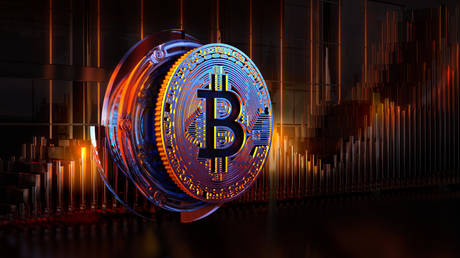Black Swan Event Could Break Global Financial System
by Andy Krieger, Casey Research:

Regular readers know that some of our top minds at Casey Research – including our founder, Doug Casey – see dark times ahead for the economy.
But instead of panicking, we’re focused on helping you profit from the catastrophe. That’s why we’re sharing this dispatch from trading legend Andy Krieger.
Now, when a trader makes $300 million in a single day we’re inclined to pay attention. But Andy’s also an expert on the imminent collapse we see coming (which he calls the Black Swan event).
It’s essential to start preparing your portfolio now.
You can start by signing up for Andy’s big trade event this Thursday, February 20 at 8 p.m. ET.
Then, read Andy’s breakdown of the dangerous situation the world’s central banks have put us in… and the unique way he’s positioned to take advantage.
By Andy Krieger, editor, Andy Krieger Trading
One of the key outcomes of the 2008 financial crisis has been a worldwide addiction to easy money – an unintended consequence of over a decade of central banks aggressively pumping vast sums into the system.
It all started in 2008 when, in a desperate effort to stave off financial Armageddon, central banks resorted to quantitative easing and seemingly endless printing of money in the hope of preventing the total collapse of a beleaguered global financial system.
This move prevented the collapse, but the central banks have continued the printing to this day… and the easy money gets quickly sucked up by the addicts – all of us.
So, what was supposed to be a temporary, emergency fix has become a seemingly permanent dependency. The U.S. Federal Reserve’s balance sheet is now trillions of dollars bigger, as is that of the European Central Bank’s (ECB), and the Bank of Japan’s (BOJ).
And this printing shows no signs of slowing down.
But I’m not writing today only to report on our tenuous financial system. Additionally, I’m going to offer some advice:
The easy money situation, while certainly easy to loathe, is just as easily exploited. It’s been exploited for over a decade, and fighting its impact has been a terrible idea.
Global stock markets have been floated on these giant pools of liquidity, and the economic expansion has been dragged along, somewhat unnaturally without an interruption. This has been a brutal time for many short sellers of stocks!
It’s the savvy investors – the ones who can play both sides of a trade and use proper risk-management – who will make out like bandits… and at the end of today’s essay, I’ll describe one of the ways I’m doing it.
Breaking the Addiction
It is astonishing how quickly the world has become addicted to easy money – absorbing trillions of dollars, euros, and yen with an insatiable appetite.
Even more astonishing is that any hint of removing this artificial, economic life support sends the markets into a dizzying tailspin – as we saw in September 2018, when the Fed hiked interest rates to 2.25% and the S&P 500 began a sell-off that would take it 17% lower by December.
How we’ll ever break this addiction is unclear… but break it we must.
Before I go on, let me put things in perspective. Right before the 2008 financial crisis, short-term interest rates in the U.S., Europe, and Australia, respectively, were 4.75%, 3.65%, and 7%.
Compare these rates to the current rates of negative 0.45%, 1.45%, and 0.75%…
This, however, is only part of the picture. Consider the fact that over $15 trillion worth of debt has been issued at negative interest rates… And investors happily buy into this madness. Think about what this means.
I refer to this as a classic example of the greater fool theory. With negative interest rates, somebody lends his money to the borrower, who will work with this money for 10 years – and the lender has to pay the borrower to do this.
Why should someone do this? It sounds crazy. If I lend someone my money, I want to be paid for the usage of that money and for the risk that I might not get it paid back to me. In this scenario, the lenders hope that somebody will come along after them and pay the borrower even more money for the right to lend his money… thus driving up the price of the bonds.
This latter borrower is the de facto “greater fool.”
It’s like a wild game of musical chairs. You just don’t want to be holding the sack of ever-depreciating debt when the music stops playing.
And despite all the easy money, and the dramatic lowering of interest rates, the deflationary headwinds are still blowing strongly…
This year, the growth rate in Europe will be anemic – optimistically around 1%. The U.S. growth rate will come in around 2.5%. And Australia’s GDP will probably come in around 0.9% for this year. (In the U.S., this growth rate is really quite modest in light of massive government spending and a ballooning budget deficit.)
In terms of the nominal levels of interest rates… frankly, I can’t imagine that I would be any more inclined to make purchases or engage in business activities because interest rates have been lowered from 75 basis points to 25… Or even from 25 to negative 25.
And once rates go negative, do lower interest rates really act as a proper business stimulant? I don’t think so.
On the other hand, the American economy is remarkably creative and adaptive… and the people in America are very hard-working. This has facilitated the growth of the economy to levels which make the fiscal irresponsibility of Washington – and the overly rosy picture it paints – almost manageable.
Critical Juncture
Regardless, we are now at a critical juncture in the global economy, because the second-largest economy in the world, China’s, has come to a near standstill due to the coronavirus.
It was highly predictable that the Chinese central bank would resort to the same practices that the ECB, the Fed, and the BOJ have truly mastered – pumping hundreds of billions of dollars (or more) into the system to float its economy out of trouble.
But the record bankruptcies, and terrifying levels of bad loans on bank balance sheets, will be happily ignored by global investors. The Chinese government will underwrite all of these problems with monetary bandages, while hoping that the economy will grow its way out of trouble over time.
Investors will feel relieved, and global stock markets can continue their seemingly inexorable climb to higher and higher levels.
This is, however, a VERY dangerous situation…
All Is “Rosy”
What happens when the next recession comes, and a financial crisis rears its ugly head?
The central banks will be largely out of ammunition. And they may have more targets to fire at than bullets in their arsenal.
For sure, the Fed will implement even more aggressive levels of quantitative easing… ballooning the central bank’s balance sheet to almost unimaginable levels. This would be a desperate move, but they would have few alternatives. Would it work? Maybe.
The situation in Europe is even more tenuous, as the economy there is more fragile than the authorities would like us to believe. (Just ask the ECB how its experiment is working out!) The negative interest rates make it difficult for the banks to earn profits… and many banks there are terribly undercapitalized.
This fragility and vulnerability is a topic that I will be discussing at some length with my apprentices, as we need to be ready to take certain protective steps when the situation becomes too risky. But for now, I guess I will be a willing, conscious participant in a version of the “greater fool” trading game.
This means that I will ignore the very real danger lurking in the shadows and accept that, for the time being, all is “rosy” and “wonderful.” Bad and dangerous things should be ignored, and we should assume that printing more and more money will cover up and address any serious problem.
Accordingly, I recommend staying short currencies like the Japanese yen, Swiss franc, and euro… And hold a small basket of currencies against them, the Canadian dollar and U.S. dollar in particular.
This could turn out to be a big trade which persists for quite some time. So I am playing it with trailing stops. If one day the market wakes up and realizes how frighteningly fragile everything is, then I will get stopped out of these positions with some profits. Otherwise, I may end up holding these positions for quite a while.
Even if the trade goes sideways for a while, I will earn plenty of money since I am earning a positive carry on the position. I finance my position by borrowing liability currencies that all have negative interest rates (Swiss rates are negative .7%, Euro rates are negative .45%, and Japanese rates are negative .17%) and invest in asset currencies with positive interest rates (U.S. rates are at 1.5% and Canadian rates are at 1.6%).
Loading...



